USER GUIDE
User Guide
INSTALLATION
For help with installation, click on the "QUICK SETUP" button above to view guides on loading Melody Sauce in your DAW.
SERIAL NUMBERS - for any serial number issues, see our Support Guides:
QUICK HELP TIPS
Once you’ve completed the set-up you are ready to begin creating melodies right away.
Click on the help tips icon in the top right corner to display the quick tips window to get help get you started:
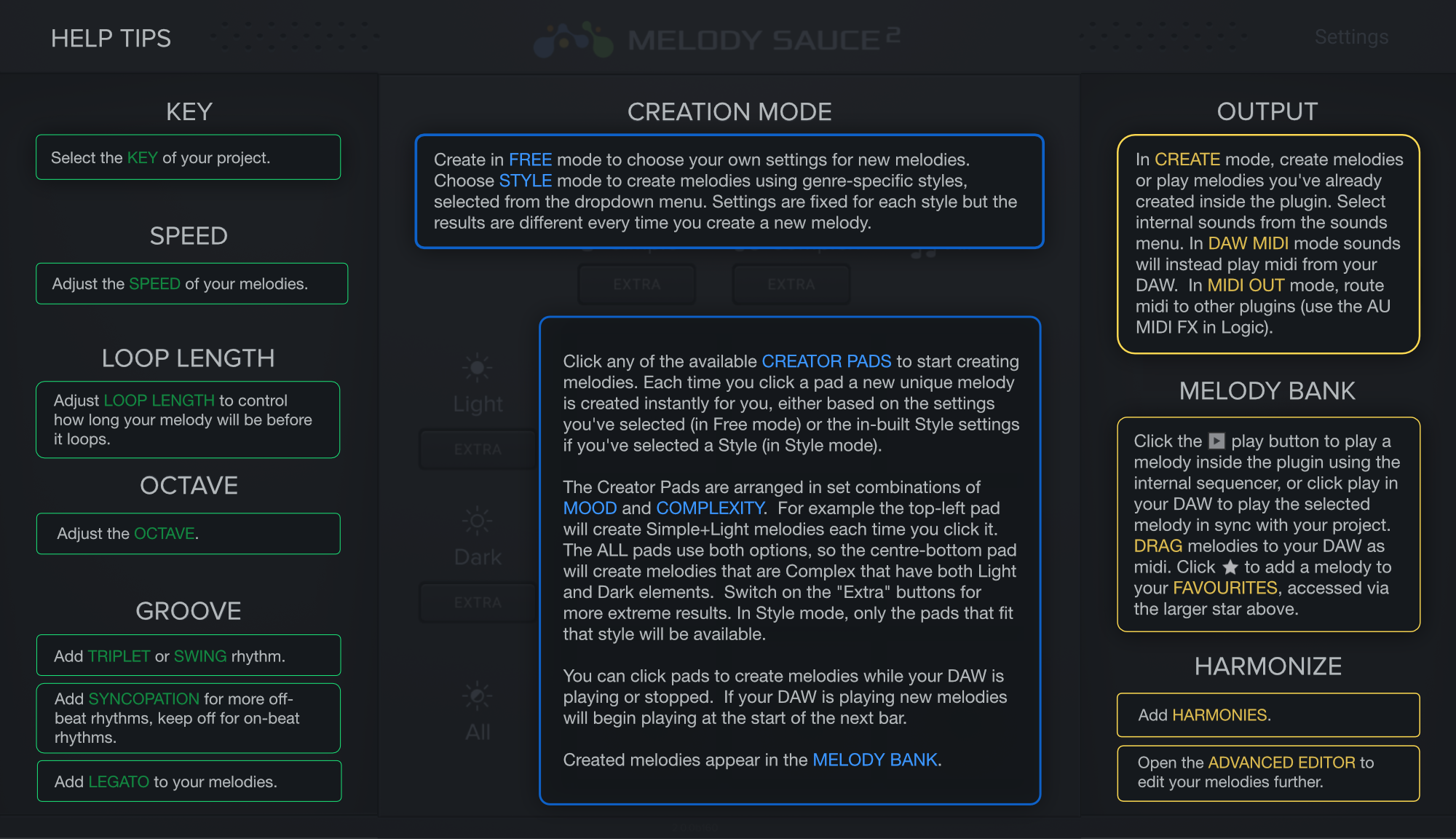

INTERFACE
Since finding the right melody is often about trying different ideas out over other song elements, Melody Sauce 2's simple interface is designed to allow you to experiment with the various settings and easily create and audition different types of melody whilst playing your project.
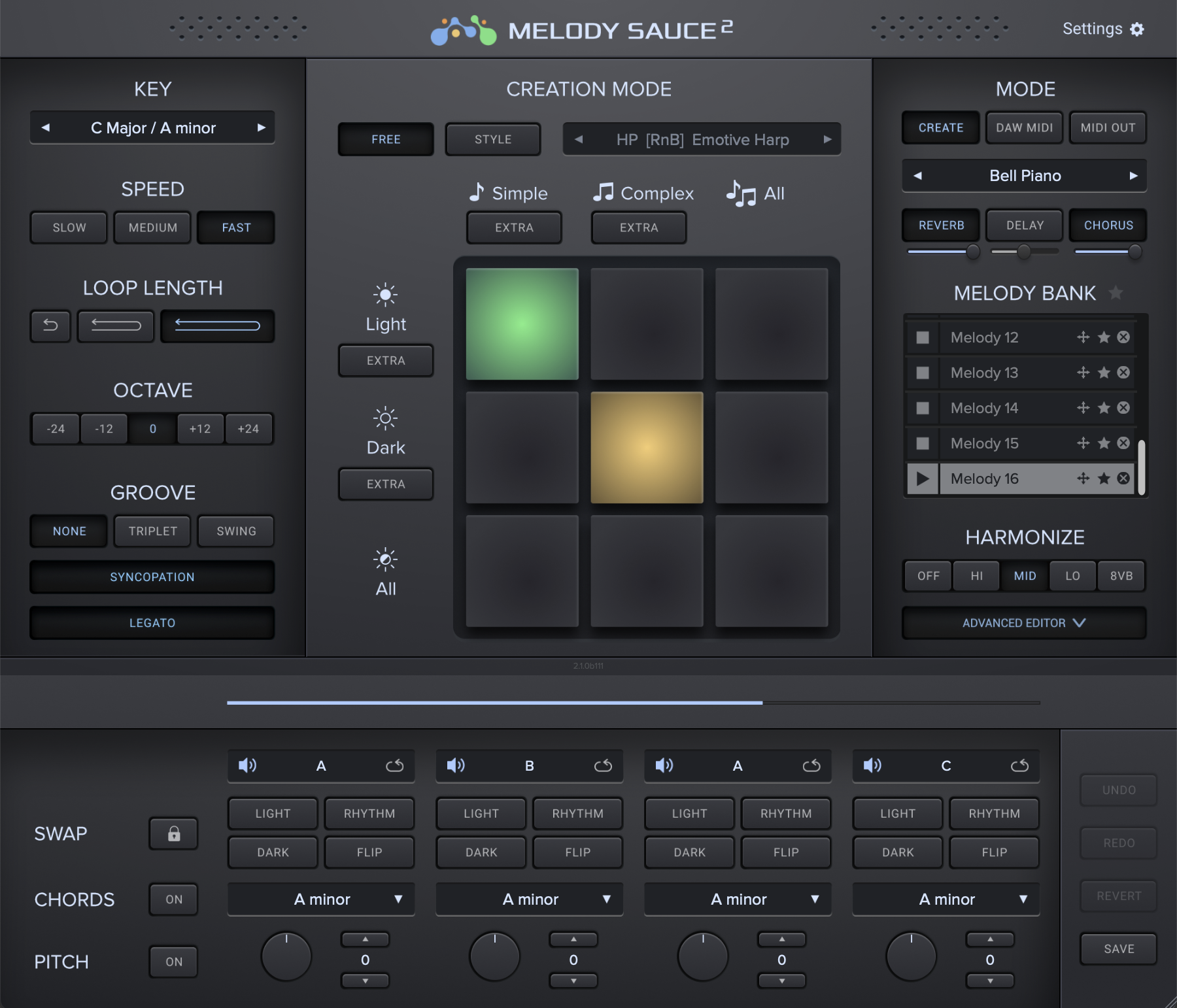
1. CENTER OF UI - CREATION CONTROLS
1.1 FREE OR STYLE MODE

FREE Mode is our basic mode where you select your own settings to control the generated melodies.
STYLE Mode allows you to create unique melodies for specific genres using our internal Style settings - simply choose a style from the drop-down menu.
Styles always load with their default settings, however you can still make adjustments to the controls and any new melodies will be created based on the current settings in the UI. When the settings in the UI have been modified from the style’s default settings, the style will have a “ * ” after its name in the Style panel.
(You can change this behaviour by clicking on the Settings menu and selecting “Always use style default settings for new melodies”).
1.2 CREATOR PADS

As soon as you’ve loaded Melody Sauce 2 you can start creating melodies straight away by clicking any available CREATOR PAD in the center of the UI.
Each time you click a pad a new unique melody is created instantly for you, either based on the settings you've selected (in Free mode) or the in-built Style settings if you've selected a Style (in Style mode). The pads are initially grey when active, but once you click one they will illuminate in time with the created melodies. (Note: In Style mode, only pads that fit that style will be available the others will be grayed-out).
1.3 MOOD & COMPLEXITY

To make it easy to experiment with these “on the fly” as you play your project, the Creator Pads are arranged in set combinations of MOOD and COMPLEXITY, so that you can easily select a different combination by simply clicking a different pad.
The complexity option labels run horizontally across the top of the creator pads display, mood option titles run vertically down the side of the pads. Complexity options are 'Simple', 'Complex' or 'All'. Mood options are 'Light', 'Dark', or 'All'. E.g. the top-left pad will create Simple + Light melodies each time you click it. The ALL pads use both options, so the centre-bottom pad will create melodies that are Complex and that have both Light and Dark elements. Switch on the "EXTRA" buttons for more extreme results.
Once you click one of the creator pads, Melody Sauce 2 instantly creates a 4-bar, 8-bar or 16-bar melody depending on the speed you’ve selected, and if your project is already playing Melody Sauce 2 will automatically plays this at the start of the next bar, and the pads will illuminate in time with this melody.
Melody Sauce 2 automatically syncs to your DAW’s internal clock and timeline. To get the created melodies to play in the correct sequence it works best if you place your song’s elements in standard positions 4-bar positions (e.g. at the start of bars 1, 5, 9, 13, 17 etc). Melody Sauce 2 will continue to loop-play the melody from this point. You can continuously audition new melodies whilst your song plays by repeatedly pressing creator pads, and you could even create melodies in a live performance setting.
2 . LEFT SIDE OF UI
Changing these settings will have an instant effect on all Melody Sauce 2’s output - you can select them before you create a melody, or you can select them after to instantly modify the melodies you’ve already created.
As creating melodies with Melody Sauce 2 is so simple, you can easily experiment with the above settings until you find the right melody.
2.1 KEY
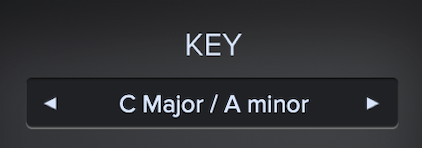
Select a key from the KEY dropdown menu - this should be the key of the project you’re working on. The keys are organised in major and relative minor pairs (e.g.: C Major / A Minor). If you’re having trouble finding which key you’re in, you can use the up/down arrow buttons to shift up or down in semitone increments until your melody sounds in key.
2.2 SPEED

Select whether Melody Sauce will create SLOW, MEDIUM or FAST melodies. This will partly depend on the overall tempo of your track. As a rough guide, select Medium for tempos around 140 bpm and above, Fast for tempos around 80 bpm or slower, and either for anything in between.
Slow will play your melody in a half speed style, perfect for Trap producers who produce at double-speed tempos.
2.3 LOOP LENGTH

Select a SHORT, MEDIUM or LONG loop length to adjust how long the melody will be before it loops. The longer the loop, the more notes will play.
2.4 OCTAVE

Set the output to shift the higher or lower by octaves.
2.5 GROOVE SECTION

Selecting SWING gives your melodies more of a skipped feel. TRIPLET rhythms are three-note patterns that fill the length of a typical two-note pattern. These tend to work best with the Fast speed setting.
The SYNCOPATION button allows you to control whether your melody has syncopated 'offbeat' rhythms. When ON, the melody will almost always contain some offbeat rhythms. When not selected, the melody will have only on-beat 'straight' rhythms.
Click the LEGATO button to make the notes longer.
3. RIGHT SIDE OF UI
3.1 MODE

There are now 3 general modes to select from:
CREATE mode: this is Melody Sauce’s current standard operation - create melodies or play the melodies you have created inside the plugin. Melodies will play via the internal midi-generation engine using the plugin’s sounds.
DAW MIDI mode: this new mode allows Melody Sauce 2 to play incoming midi from your DAW, so any midi placed on the same track as Melody Sauce 2 will be played by the plugin’s sounds. This means you can drag midi melodies from the plugin to your DAW and Melody Sauce 2 will play these directly from the DAW. This also allows you to use Melody Sauce 2’s instruments like a regular virtual software synth via your own midi or a midi keyboard.
MIDI OUT mode: select this mode to route the midi to other software instruments.
To route MIDI to another software instrument in your DAW, please refer to the Setup Guide for your DAW.
3.2 SOUNDS AND FX
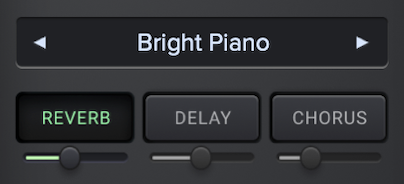
When in CREATE or DAW MIDI modes, select one of internal sounds in the Sounds dropdown window, and apply any of 3 FX. Click the button for each FX to turn it on and move the sliders from left to right to increase the amount of FX applied.
3.3 MELODY BANK

Created melodies appear in the Melody Bank. You can either play a melody inside Melody Sauce 2 using Melody Sauce 2's own playback engine without having to play your DAW - control internal playback of any melody via its start-stop icon. The selected melody will also when you hit play to launch your DAW.
Drag & Drop: You can grab any melody and drag it out of the Melody Bank and directly into your DAW as MIDI.
Favourite: Click the "Star" icon next to a melody to add it to the FAVOURITES Bank, which is accessed by clicking the large star above the Melody Bank.
Delete: Click the "X" icon to delete any melodies individually.
Melodies can be renamed in the Melody Bank, just click on their current names. To clear the melody bank select “Clear Melody Bank” from the Settings menu.
Note: FL STUDIO - FL Studio allows you to drop MIDI directly into the Channel Rack or into an instrument’s Piano Roll. Alternatively you can drag the melody melodies to your desktop and import them.
3.4 HARMONIZE:

Clicking one of the HARMONIZE buttons allows you to instantly add simple 2-part harmonies to your melodies. The 8vb button doubles the current melody an octave below, and Lo, Mid and Hi add different harmonies.
4. ADVANCED EDITOR

Clicking the Advanced Editor button opens the Advanced Editor panel at the bottom of the UI, which contains various tools for editing your melodies.
4.1 MELODY BLOCKS

Melodies are divided into 4 lane-type Blocks which can be edited separately. At Fast speed each block is 1-bar long, at Medium speed they are 2 bars long, and Slow speed they are 4-bars long.
The phrase in each block is represented by a letter, so in a sequence of blocks "AAAA" all blocks have the same phrase, in sequence "ABCD" the phrases are all different.
CLICK-DRAG a block to copy it to a new position.
SHIFT-DRAG a block to swap it with another.
4.2 MUTE OR LOOP

Click the "Sound" icon to MUTE a block. Click the other icon to LOOP a block.
4.3 LIGHT OR DARK SWAP, FLIP NOTES, SWAP RHYTHM

Use the SWAP buttons to swap the current phrase in a block with a new light or dark phrase or a new rhythm, or flip to invert the shape of the notes in a block.
Click LIGHT or DARK for new Light or Dark notes.
Click RHYTHM for a new rhythm.
Click FLIP to invert the shape of the existing note sequence.
Use the "LOCK" button on the left hand side to apply any Swap to all phrases of a melody at the same time.
When a block has been modified from its original state a “ * ” will appear after the block letter e.g. “ B* ”.
4.4 CHORD ADJUST

CHORD ADJUST allows you to select specific chords for each block of your melodies to follow, either before or after you've created a melody. For example, selecting “F Major” will force any notes in that block to fit with an F Major chord.
The available chords will change depending on the mood of your melody.
Switch Chord Adjust ON to apply chords.
4.5 EDIT PITCH

PITCH ADJUST allows you to adjust the pitch of each block up and down. The adaptive pitch shifting is different to standard semitone pitch shifting as it always keeps your phrases in-key.
Switch Pitch Adjust ON to apply.
4.6 UNDO/REDO, REVERT OR COPY
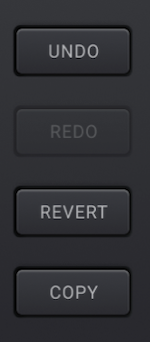
UNDO or REDO any changes you make in the Advanced Editor.
REVERT to put your melody back to its original state.
COPY to add a duplicate copy of your melody to the Melody Bank.
5. SETTINGS
Along with options to change some of the default behaviours of some of the functions mentioned, the Settings menu allows you to do the following:

5.1 EXPORT FAVOURITES
Bulk-export all your favourited melodies in the Favourites bank as midi files.
5.2 BUTTON COLOR
You can select 1 of 3 color options for the UI buttons.
5.3 DE-AUTHORIZE COMPUTER
Your Melody Sauce 2 serial number (license key) is limited to activation on a maximum of 3 separate computers. You can de-activate Melody Sauce 2 on a computer by loading the plugin on that computer and selecting “De-authorize This Computer”.
5.4 CHECK FOR UPDATES
Click "Check for Update" to open a link in your browser to your account page (requires account registration), where any available updates will appear in the Downloads area.
5.5 HELP
Clicking help will display the help windows containing explanations of the various controls on the UI.
SUPPORT
For any support questions please visit https://evabeat.com/support/.
FAQS
If you have any pre-sales questions about Melody Sauce before you buy, or need post-sales help installing or using Melody Sauce 2's, please take a look at our extensive FAQs. Below are some of our most asked FAQs.
Melody Sauce FAQs
Yes, students can get 25% off and music education faculties can buy a 10 seat license at 50% off. More details here.
As you have already activated your Melody Sauce 2 upgrade you don't need to complete the full upgrade process on each subsequent computer you want to use.
After upgrading, your Melody Sauce 2 upgrade serial (license key) is used like a full serial. Simply copy and paste your Melody Sauce 2 serial (license key) in the first serial screen you come to - it should only have space for 1 serial (license key).
If you get an invalid serial error, please follow the steps in the FAQ: Full version of Melody Sauce 2: I get a serial not valid error.
Make sure to follow the first 3 steps below. If you still have an invalid serial error, then move on to the subsequent steps.
1. Make sure you enter your full Melody Sauce 2 serial (license key)l in the correct serial screen in the Melody Sauce 2 plugin - it is the first screen you come to when opening the plugin for the first time.
2. Copy and paste to enter your serial (license key).
- For Mac 1. Use Command-C to copy serial number 2. Click your cursor inside the serial box first 3. Then use Command-V to paste serial (license key)
- For Windows 1. Use Control-C to copy serial number 2. Click your cursor inside the serial box first 3. Then use Control-V to paste serial (license key)
Note: Make sure there are no spaces at the start when you paste. Pay attention to the serial format xxxx-xxxx-xxxx-xxxx-xxxx. If any of the 5 sections of characters is only 3 characters long then you have accidentally added a space at the start.
3. Make sure you have a stable internet connection during the activation process.
4. Delete the "license_file" and "serial_file" files from the following location:
For OS X: /Users/<username>/Library/Keyzy/
For Windows: HKEY_CURRENT_USER\\Software\\Keyzy\\
Here is some info on how to access the Registry Files in Windows.
When you go to the "Software" folder in the registry, you should be able to see a "Keyzy" sub-folder, and in there are the 2 files to delete.
Once you have deleted the files, load the plugin and copy and paste your serial (license key) again.
5. If you have accessed your registry and there is no license-file or no Keyzy folder at all, this confirms that you have a firewall setting that is preventing Melody Sauce 2 from writing the necessary files to your computer. Turn any firewalls off during the activation process and also note that some VPNs can cause issues too.
For Windows users, here is some info on how to configure Windows Defender to allow programs like Melody Sauce 2 to be installed properly.
Make sure to follow the first 3 steps below. If you still have an invalid serial error, then move on to the subsequent steps.
1. Make sure you enter your Melody Sauce 2 Upgrade serial in the correct serial (license) screen in the Melody Sauce 2 plugin. To get to this screen, press the upgrade button on the first screen you come to when opening Melody Sauce 2. You should see space for 2 serials (license keys) to be added.
2. Make sure you copy and paste your original Melody Sauce version 1 serial (license key) in the first white section.
- For Mac 1. Use Command-C to copy serial (license key) number 2. Click your cursor inside the serial box first 3. Then use Command-V to paste serial (license key)
- For Windows 1. Use Control-C to copy serial (license key) number 2. Click your cursor inside the serial box first 3. Then use Control-V to paste serial (license key)
Note: Make sure there are no spaces at the start when you paste. Pay attention to the serial (license key) format xxxx-xxxx-xxxx-xxxx-xxxx. If any of the 5 sections of characters is only 3 characters long then you have accidentally added a space at the start.
4. Once you successfully paste your original Melody Sauce version 1 serial (license key) the second space for a serial (license key) becomes available. Copy and paste your Melody Sauce 2 upgrade serial (license key) in the space and click the blue upgrade button.
If the activation isn't successful, please make sure you followed the first 4 steps accurately and then move on to the next steps below.
5. Make sure you have a stable internet connection during the activation process.
6. Delete the "license_file" and "serial_file" files from the following location:
For OS X: /Users/<username>/Library/Keyzy/
For Windows: HKEY_CURRENT_USER\\Software\\Keyzy\\
Here is some info on how to access the Registry Files in Windows.
When you go to the "Software" folder in the registry, you should be able to see a "Keyzy" sub-folder, and in there are the 2 files to delete.
Once you have deleted the files, load the plugin and go through the upgrade process again.
7. If you have accessed your registry and there is no license-file or no Keyzy folder at all, this confirms that you have a firewall setting that is preventing Melody Sauce 2 from writing the necessary files to your computer. Turn any firewalls off during the activation process and also note that some VPNs can cause issues too.
For Windows users, here is some info on how to configure Windows Defender to allow programs like Melody Sauce 2 to be installed properly.
The serial (license key) is sent to you by email from Sealbucket. You may need to check your junk folder.
If you haven't received your serial please open a support ticket and we'll send you it.
You can also view your serial in your Evabeat account if you have purchased from our site.
You can find this in the email you received from Sealbucket (older customers might have received their email from Keyzy.io) when you first purchased Melody Sauce 1, or by logging into your account page.
If you can't write inside the serial (license key) space, use copy and paste to add your serial (license key). We recommend this anyway, as it is the best way to avoid inputting errors.
- For Mac 1. Use Command-C to copy serial number 2. Click your cursor inside the serial (license key) box first 3. Then use Command-V to paste serial (license key)
- For Windows 1. Use Control-C to copy serial number 2. Click your cursor inside the serial (license key) box first 3. Then use Control-V to paste serial (license key)
Note: Make sure there are no spaces at the start when you paste. Pay attention to the serial (license key) format xxxx-xxxx-xxxx-xxxx-xxxx. If any of the 5 sections of characters is only 3 characters long then you have accidentally added a space at the start.
You can view our release notes here https://www.evabeat.com/release-notes which will be updated shortly after each release of Melody Sauce 2.
You can view our release notes here https://www.evabeat.com/release-notes which will be updated shortly after each release of Melody Sauce 2.
Yes, students can get 25% off and music education faculties can buy a 10 seat license at 50% off. More details here.
If you can't write inside the serial (license key) space, use copy and paste to add your serial (license key). We recommend this anyway, as it is the best way to avoid inputting errors.
- For Mac 1. Use Command-C to copy serial number 2. Click your cursor inside the serial (license key) box first 3. Then use Command-V to paste serial (license key)
- For Windows 1. Use Control-C to copy serial number 2. Click your cursor inside the serial (license key) box first 3. Then use Control-V to paste serial (license key)
Note: Make sure there are no spaces at the start when you paste. Pay attention to the serial (license key) format xxxx-xxxx-xxxx-xxxx-xxxx. If any of the 5 sections of characters is only 3 characters long then you have accidentally added a space at the start.
As you have already activated your Melody Sauce 2 upgrade you don't need to complete the full upgrade process on each subsequent computer you want to use.
After upgrading, your Melody Sauce 2 upgrade serial (license key) is used like a full serial. Simply copy and paste your Melody Sauce 2 serial (license key) in the first serial screen you come to - it should only have space for 1 serial (license key).
If you get an invalid serial error, please follow the steps in the FAQ: Full version of Melody Sauce 2: I get a serial not valid error.
Make sure to follow the first 3 steps below. If you still have an invalid serial error, then move on to the subsequent steps.
1. Make sure you enter your Melody Sauce 2 Upgrade serial in the correct serial (license) screen in the Melody Sauce 2 plugin. To get to this screen, press the upgrade button on the first screen you come to when opening Melody Sauce 2. You should see space for 2 serials (license keys) to be added.
2. Make sure you copy and paste your original Melody Sauce version 1 serial (license key) in the first white section.
- For Mac 1. Use Command-C to copy serial (license key) number 2. Click your cursor inside the serial box first 3. Then use Command-V to paste serial (license key)
- For Windows 1. Use Control-C to copy serial (license key) number 2. Click your cursor inside the serial box first 3. Then use Control-V to paste serial (license key)
Note: Make sure there are no spaces at the start when you paste. Pay attention to the serial (license key) format xxxx-xxxx-xxxx-xxxx-xxxx. If any of the 5 sections of characters is only 3 characters long then you have accidentally added a space at the start.
4. Once you successfully paste your original Melody Sauce version 1 serial (license key) the second space for a serial (license key) becomes available. Copy and paste your Melody Sauce 2 upgrade serial (license key) in the space and click the blue upgrade button.
If the activation isn't successful, please make sure you followed the first 4 steps accurately and then move on to the next steps below.
5. Make sure you have a stable internet connection during the activation process.
6. Delete the "license_file" and "serial_file" files from the following location:
For OS X: /Users/<username>/Library/Keyzy/
For Windows: HKEY_CURRENT_USER\\Software\\Keyzy\\
Here is some info on how to access the Registry Files in Windows.
When you go to the "Software" folder in the registry, you should be able to see a "Keyzy" sub-folder, and in there are the 2 files to delete.
Once you have deleted the files, load the plugin and go through the upgrade process again.
7. If you have accessed your registry and there is no license-file or no Keyzy folder at all, this confirms that you have a firewall setting that is preventing Melody Sauce 2 from writing the necessary files to your computer. Turn any firewalls off during the activation process and also note that some VPNs can cause issues too.
For Windows users, here is some info on how to configure Windows Defender to allow programs like Melody Sauce 2 to be installed properly.
You can find this in the email you received from Sealbucket (older customers might have received their email from Keyzy.io) when you first purchased Melody Sauce 1, or by logging into your account page.
Make sure to follow the first 3 steps below. If you still have an invalid serial error, then move on to the subsequent steps.
1. Make sure you enter your full Melody Sauce 2 serial (license key)l in the correct serial screen in the Melody Sauce 2 plugin - it is the first screen you come to when opening the plugin for the first time.
2. Copy and paste to enter your serial (license key).
- For Mac 1. Use Command-C to copy serial number 2. Click your cursor inside the serial box first 3. Then use Command-V to paste serial (license key)
- For Windows 1. Use Control-C to copy serial number 2. Click your cursor inside the serial box first 3. Then use Control-V to paste serial (license key)
Note: Make sure there are no spaces at the start when you paste. Pay attention to the serial format xxxx-xxxx-xxxx-xxxx-xxxx. If any of the 5 sections of characters is only 3 characters long then you have accidentally added a space at the start.
3. Make sure you have a stable internet connection during the activation process.
4. Delete the "license_file" and "serial_file" files from the following location:
For OS X: /Users/<username>/Library/Keyzy/
For Windows: HKEY_CURRENT_USER\\Software\\Keyzy\\
Here is some info on how to access the Registry Files in Windows.
When you go to the "Software" folder in the registry, you should be able to see a "Keyzy" sub-folder, and in there are the 2 files to delete.
Once you have deleted the files, load the plugin and copy and paste your serial (license key) again.
5. If you have accessed your registry and there is no license-file or no Keyzy folder at all, this confirms that you have a firewall setting that is preventing Melody Sauce 2 from writing the necessary files to your computer. Turn any firewalls off during the activation process and also note that some VPNs can cause issues too.
For Windows users, here is some info on how to configure Windows Defender to allow programs like Melody Sauce 2 to be installed properly.
The serial (license key) is sent to you by email from Sealbucket. You may need to check your junk folder.
If you haven't received your serial please open a support ticket and we'll send you it.
You can also view your serial in your Evabeat account if you have purchased from our site.

